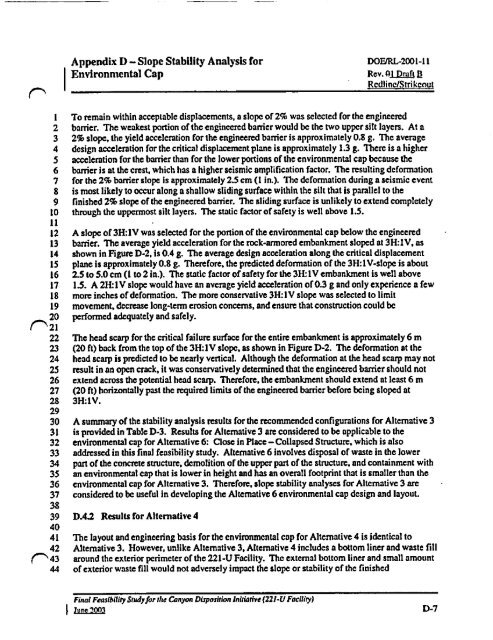View Document Here - Hanford Site
View Document Here - Hanford Site
View Document Here - Hanford Site
Create successful ePaper yourself
Turn your PDF publications into a flip-book with our unique Google optimized e-Paper software.
Appendix D - Slope Stability Analysis for poFJRt,-2001-1 t<br />
Environmental Cap Rev. o Draft ts<br />
I To remain within acceptable displacements, a slope of 2% was selected for the engineered<br />
2 barrier. The weakest portion of the engineered barrier would be the two upper silt layers. At a<br />
3 2% slope, the yield acceleration for the engineered barrier is approximately 0.8 g. The average<br />
4 design acceleration for the critical displacement plane is approximately 1.3 g. There is a higher<br />
5 acceleration for the barrier than for the lower portions of the environmental cap because the<br />
6 barrier is at the crest, which has a higher seismic amplification factor. The resulting deformation<br />
7 for the 2% barrier slope is approximately 2.5 cm ( 1 in.). The deformation during a seismic event<br />
8 is most likely to occur along a shallow sliding surface within the silt that is parallel to the<br />
9 finished 2% slope of the engineered barrier. The sliding surface is unlikely to extend completely<br />
10 through the uppermost silt layers. The static factor of safety is well above 1.5.<br />
11<br />
12 A slope of 3H:IV was selected for the portion of the environmental cap below the engineered<br />
13 barrier. The average yield acceleration for the rock-armored embankment sloped at 3H:1 V, as<br />
14 shown in Figure D-2, is 0.4 S. The average design acceleration along the critical displacement<br />
15 plane is approximately 0.8 g. Therefore, the predicted deformation of the 3H:1 V-sfopc is about<br />
16 2.5 to 5.0 em (t to 2 in.). The static factor of safety for the 311:1 V embankment is well above<br />
17 1.5. A 2H:1 V slope would have an average yield acceleration of 0.3 g and only experience a few<br />
18 more inches of deformation. The more conservative 3H:1 V slope was selected to limit<br />
19 movement, decrease long-term erosion concerns, and ensure that construction could be<br />
20 performed adequately and safely.<br />
21<br />
22 The head scarp for the critical failure surface for the entire embankment is approximately 6 in<br />
23 (20 ft) back from the top of the 31-1:1V slope, as shown in Figure D-2. The deformation at the<br />
24 head scarp is predicted to be nearly vertical. Although the deformation at the head scarp may not<br />
25 result in an open crack, it was conservatively determined that the engineered barrier should not<br />
26 extend across the potential head scarp. Therefore, the embankment should extend at least 6 in<br />
27 (20 ft) horizontally past the required limits of the engineered barrier before being sloped at<br />
28 3H:1 V.<br />
29<br />
30 A summary of the stability analysis results for the recommended configurations for Alternative 3<br />
31 is provided in Table D-3. Results for Alternative 3 are considered to be applicable to the<br />
32 environmental cap for Alternative 6: Close in Place - Collapsed Structure, which is also<br />
33 addressed in this final feasibility study. Alternative 6 involves disposal of waste in the lower<br />
34 part of the concrete structure, demolition of the upper part of the structure, and containment with<br />
35 an environmental cap that is lower in height and has an overall footprint that i s smaller than the<br />
36 environmental cap for Alternative 3. Therefore, slope stability analyses for Alternative 3 are<br />
37 considered to be useful in developing the Alternative 6 environmental cap design and layout.<br />
38<br />
39 D.4.2 Results for Alternative 4<br />
40<br />
41 The layout and engineering basis for the environmental cap for Alternative 4 is identical to<br />
42 Alternative 3. However, unlike Alternative 3, Alternative 4 includes a bottom liner and waste fill<br />
(^ 43 around the exterior perimeter of the 221-U Facility. The external bottom liner and small amount<br />
44 of exterior waste fill would not adversely impact the slope or stability of the finished<br />
Final Featibiliy Study jor the Canyon Disporition Initiative (221-U Faeiliry)<br />
une 2001 D-7

















